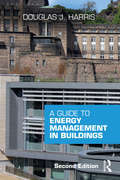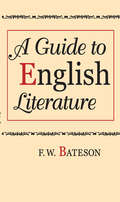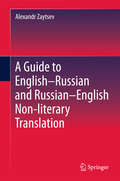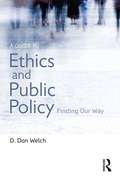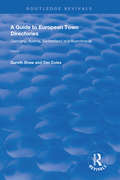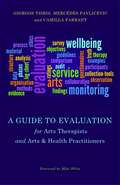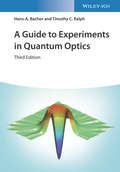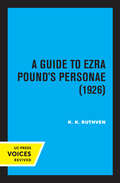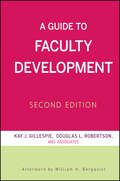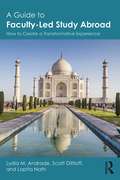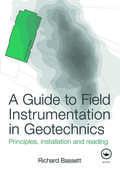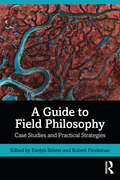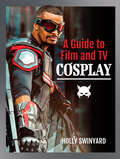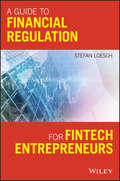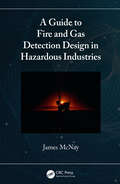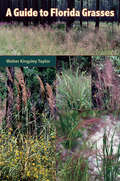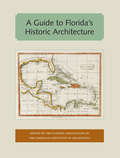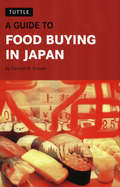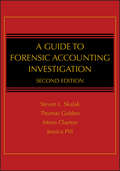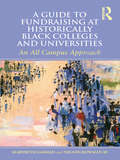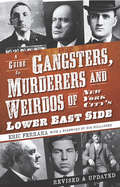- Table View
- List View
A Guide to Energy Management in Buildings
by Douglas HarrisThis new edition of A Guide to Energy Management in Buildings begins by asking why we need to control energy use in buildings and proceeds to discuss how the energy consumption of a building can be assessed or estimated through an energy audit. It then details a range of interventions to reduce energy use and outlines methods of assessing the cost-effectiveness of such measures. Topics covered include: where and how energy is used in buildings energy audits measuring and monitoring energy use techniques for reducing energy use in buildings legislative issues. And new in this edition: the cooling of buildings fuel costs and smart metering and education and professional recognition. It provides a template for instigating the energy-management process within an organization, as well as guidance on management issues such as employee motivation, and gives practical details on how to carry the process through. This book should appeal to building and facilities managers and also to students of energy management modules in FE and HE courses.
A Guide to English Literature
by F. W. BatesonAt first glance A Guide to English Literature may seem to be no more than a short bibliography of English literature with perhaps rather more extensive--and certainly more outspoken--comments on the principal editions, commentaries, biographies, and critical works than bibliographies usually provide. But it is something more: this guide contains long ""inter-chapters"" that provide reinterpretations of the principal periods of English literature in the light of modern research, as well as two final sections summarizing in unusual detail the literary criticism that exists in English and recent scholarship in the field. The purpose of this book, then, is to provide the reader with convenient access to a disciplined study of the texts themselves.This guide proposes itself as a new kind of literary history. The conventional history of literature has often tended to become a substitute for the reading of the literature it describes: the better the history, the greater the temptation to substitute it. The present combination of reading lists and inter-chapters cannot be a substitute for anything else. Meaningless as literature in themselves, they nevertheless provide the necessary preliminary information to meaningful reading. Since oddities of arrangement derive from these assumptions, the authors are not arranged alphabetically. Instead there are chronological compartments--with the divisions circa 1500, 1650, and 1800--in which authors succeed each other in the order of their births.This pioneering handbook is primarily a bibliographical laborsaving device. It is meant mostly for students and the general reader in that it stops where original research by the reader is expected to begin. However, the last chapter on literary scholarship is devoted specifically to the research specialist and provides indispensable equipment for the reader. There is also a general section on literary criticism which will be of use to all.
A Guide to English-Russian and Russian-English Non-literary Translation
by Alexandr ZaytsevLying at the intersection of translatology, cognitive science and linguistics, this brief provides a comprehensive framework for studying, investigating and teaching English-Russian/Russian-English non-literary translation. It provides a holistic perspective on the process of non-literary translation, illustrating each of its steps with carefully analyzed real-life examples. Readers will learn how to choose and process multidimensional attention units in original texts by activating different types of knowledge, as well as how to effectively devise target-language matches for them using various translation techniques. It is rounded out with handy and feasible recommendations on the structure and content of an undergraduate course in translation. The abundance of examples makes it suitable not only for use in the classroom, but also for independent study.
A Guide to Essential Human Services (2nd edition)
by Frederic G. ReamerThis book provides useful information on local, state, and government assistance programs and is beneficial to social workers, social work educators, and agencies providing services to individuals which include health care services, addictions, sexual orientation, family life education, children and adolescents, military personnel and veterans, immigrants and refugees, education and literacy, employment assistance, and legal services and dispute resolution, etc.
A Guide to Ethics and Public Policy: Finding Our Way
by D. Don WelchDeveloped by D. Don Welch during his 28 years of teaching ethics and public policy, the rationale behind A Guide to Ethics and Public Policy is to present a comprehensive guide for making policy judgments. Rather than present specific cases that raise moral issues or discuss the role a few concepts play in the moral analysis of policy, this book instead provides a broad framework for the moral evaluation of public policies and policy proposals. This framework is organized around guiding five principles: benefit, effectiveness, fairness, fidelity, and legitimacy. These principles identify the factors that should be taken into account and the issues that should be addressed as citizens address the question of what the United States government should be able to do. Organized by concept, with illustrations and examples frequently interspersed, the book covers both theory and specific issues. A Guide to Ethics and Public Policy outlines a comprehensive ethical framework, provides content to the meaning of the five principles that comprise that framework through the use of illustrations and examples, and offers guidance about how to navigate one’s way through the conflicts and dilemmas that inevitably result from a serious effort to analyze policies.
A Guide to European Town Directories: Volume One - Germany, Austria, Switzerland and Scandinavia. (Routledge Revivals)
by Gareth Shaw Tim ColesFirst published in 1997, European Directories is a major resource guide for urban historians and historical geographers. It provides a detailed bibliography of all directories published and available in major libraries throughout Germany, Austria, Switzerland, Denmark and Scandinavia. In addition, the book provides an account of the evolution of town directories, as well as giving an analysis of directory reliability and coverage. Researchers will also find an extensive bibliography for each country of literature that has utilized directory information in historical studies. The second volume includes France and southern Europe. The whole provides the first European-wide resource for those undertaking urban historical studies.
A Guide to Evaluation for Arts Therapists and Arts & Health Practitioners
by Mike White Mercedes Pavlicevic Camilla Farrant Giorgos TsirisEvaluation is crucial to the development and sustainability of Arts Therapy and Arts & Health practices. This guide supports practitioners in their quest to integrate thorough evaluation procedures in their everyday practices by providing practical guidance for designing, planning and implementing bespoke evaluation projects. Based on the authors' experience of designing and realising evaluation projects and running training workshops, a range of suggestions are offered for developing appropriate timelines and collection tools, ensuring organisational diplomacy, and managing what can be a delicate balance of truth, fact and perception. This guide will help practitioners to evaluate their services and projects by taking into consideration the unique profile of the practice, the workplace, clients, project participants, and sectors.
A Guide to Experiments in Quantum Optics
by Hans-A. Bachor Timothy C. RalphProvides fully updated coverage of new experiments in quantum optics This fully revised and expanded edition of a well-established textbook on experiments on quantum optics covers new concepts, results, procedures, and developments in state-of-the-art experiments. It starts with the basic building blocks and ideas of quantum optics, then moves on to detailed procedures and new techniques for each experiment. Focusing on metrology, communications, and quantum logic, this new edition also places more emphasis on single photon technology and hybrid detection. In addition, it offers end-of-chapter summaries and full problem sets throughout. Beginning with an introduction to the subject, A Guide to Experiments in Quantum Optics, 3rd Edition presents readers with chapters on classical models of light, photons, quantum models of light, as well as basic optical components. It goes on to give readers full coverage of lasers and amplifiers, and examines numerous photodetection techniques being used today. Other chapters examine quantum noise, squeezing experiments, the application of squeezed light, and fundamental tests of quantum mechanics. The book finishes with a section on quantum information before summarizing of the contents and offering an outlook on the future of the field. -Provides all new updates to the field of quantum optics, covering the building blocks, models and concepts, latest results, detailed procedures, and modern experiments -Places emphasis on three major goals: metrology, communications, and quantum logic -Presents fundamental tests of quantum mechanics (Schrodinger Kitten, multimode entanglement, photon systems as quantum emulators), and introduces the density function -Includes new trends and technologies in quantum optics and photodetection, new results in sensing and metrology, and more coverage of quantum gates and logic, cluster states, waveguides for multimodes, discord and other quantum measures, and quantum control -Offers end of chapter summaries and problem sets as new features A Guide to Experiments in Quantum Optics, 3rd Edition is an ideal book for professionals, and graduate and upper level students in physics and engineering science.
A Guide to Ezra Pound's Personae (1926)
by K. K. Ruthven"Both a commentary on and a critical appreciation of the work of the early Pound. It starts off with a luci introduction to Pound's technique in general, and to his imagist phase (during which the poems commented on in this book were written) in particular. In the critical passages Mr. Ruthven steers a sage middle course between the attitudes of uncritical adoration and wholesale rejection that mar so much of the literature on Pound. . . . informative without being pedantic, and exhaustive without being long-winded. . . .To turn to Mr. Ruthven's Guide is to follow in the footsteps of an intelligent, sensitive and reliable scholar." --English Studies This title is part of UC Press's Voices Revived program, which commemorates University of California Press's mission to seek out and cultivate the brightest minds and give them voice, reach, and impact. Drawing on a backlist dating to 1893, Voices Revived makes high-quality, peer-reviewed scholarship accessible once again using print-on-demand technology. This title was originally published in 1969.
A Guide to Faculty Development
by Kay William H. Bergquist Gillespie 160 J. Robertson Douglas L.Since the first edition was published, the dynamics of higher education and faculty development have greatly changed. A Guide to Faculty Development provides an introduction and a guide to faculty development as well as new topics like working with adjuncts, diversity, multiculturalism, assessment, and different issues associated with the various types of campuses. Sponsored by The Professional and Organizational Development Network in Higher Education, this revised and updated guide is essential for faculty developers and administrators newly involved as well as experienced in faculty development.
A Guide to Faculty-Led Study Abroad: How to Create a Transformative Experience
by Scott Dittloff Lydia M. Andrade Lopita NathA Guide to Faculty-Led Study Abroad provides practical information on the curricular and administrative considerations necessary to design and implement a course-based study abroad experience of the highest quality. From techniques for funding the trip, to legal considerations, curricular development, and cultural preparation, this book explains how to create a meaningful and valuable international experience in a variety of settings and formats. The study abroad novice and experienced faculty or administrator alike will benefit from this step-by-step guide on how to create a truly transformative, course-based study abroad experience.
A Guide to Feynman Diagrams in the Many-Body Problem: Second Edition
by Richard D. Mattuck"A great delight to read." -- Physics TodayAmong the most fertile areas of modern physics, many-body theory has produced a wealth of fundamental results in all areas of the discipline. Unfortunately the subject is notoriously difficult and, until the publication of this book, most treatments of the topic were inaccessible to the average experimenter or non-specialist theoretician.The present work, by contrast, is well within the grasp of the nonexpert. It is intended primarily as a "self-study" book that introduces one aspect of many-body theory, i.e. the method of Feynman diagrams. The book also lends itself to use as a reference in courses on solid state and nuclear physics which make some use of the many-body techniques. And, finally, it can be used as a supplementary reference in a many-body course.Chapters 1 through 6 provide an introduction to the major concepts of the field, among them Feynman diagrams, quasi-particles and vacuum amplitudes. Chapters 7 through 16 give basic coverage to topics ranging from Dyson's equation and the ladder approximation to Fermi systems at finite temperature and superconductivity. Appendixes summarize the Dirac formalism and include a rigorous derivation of the rules for diagrams. Problems are provided at the end of each chapter and solutions are given at the back of the book.For this second edition, Dr. Mattuck, formerly of the H. C. Orsted Institute and the University of Copenhagen, added to many chapters a new section showing in mathematical detail how typical many-body calculations with Feynman diagrams are carried out. In addition, new exercises were included, some of which gave the reader the opportunity to carry out simpler many-body calculations himself. new chapter on the quantum field theory of phase transitions rounds out this unusually clear, helpful and informative guide to the physics of the many-body problem.
A Guide to Field Instrumentation in Geotechnics: Principles, Installation and Reading
by Richard BassettGeotechnical instrumentation is used for installation, monitoring and assessment on any sizeable project, particularly in urban areas, and is used for recording, controlled remedial work, and safety. This unique and up-to-date book deals with the conceptual philosophy behind the use of instruments, and then systematically covers their practical use
A Guide to Field Philosophy: Case Studies and Practical Strategies
by Robert Frodeman Evelyn BristerPhilosophers increasingly engage in practical work with other disciplines and the world at large. This volume draws together the lessons learned from this work—including philosophers’ contributions to scientific research projects, consultations on matters of policy, and expertise provided to government agencies and non-profits—on how to effectively practice philosophy. Its 22 case studies are organized into five sections: I Collaboration and Communication II Policymaking and the Public Sphere III Fieldwork in the Academy IV Fieldwork in the Professions V Changing Philosophical Practice Together, these essays provide a practical, how-to guide for doing philosophy in the field—how to find problems that can benefit from philosophical contributions, effectively collaborate with other professionals and community members, make fieldwork a positive part of a philosophical career, and anticipate and negotiate the sorts of unanticipated problems that crop up in direct public engagement. Key features: Gives specific advice on how to integrate philosophy with outside groups. Offers examples from working with the public and private sectors, community organizations, and academic groups. Provides lessons learned, often summarized at the end of chapters, for how to practice philosophy in the field.
A Guide to Film and TV Cosplay
by Holly Swinyard"This guide offers background information about how contemporary cosplay has developed as well as nuts and bolts practical information for those wishing to start or continue participation in the hobby." — BooklistHave you ever wanted to escape into a comic book and become your favourite superhero? Or run away into the world of Disney princesses? Well, who says you can’t? Maybe it’s time you get your cosplay on! Cosplay is a hobby that is sweeping the globe, you can see it at comic cons, book launches, movie screenings and even on popular TV shows such as The Big Bang Theory and Community. A mix of exciting craft skills, heady escapism and passion for pop culture, it’s easy to see why cosplay has become so popular with people no matter who they are, because now they can be anyone they want, and so can you. But how, why and where could you have a go at starting out in the wonderful world of cosplay? With a little bit of help from this handy, dandy guide to cosplay, you can get stuck in. Learn about the history of the hobby (it’s been around longer than you’d think!), get your head around picking you’re first costume, find out how about all the amazing skills people are using to make these costumes, and perhaps even try a few yourself. Who knows, you might be rocking our as Captain Marvel or Flynn Rider at the next big comic con! (And don’t worry, there’s a guide to comic con in here too.)
A Guide to Financial Regulation for Fintech Entrepreneurs
by Stefan LoeschThe Fintech Entrepreneur’s Guide to Regulation and Regulatory Strategy Fintech has been growing dramatically over the last few years, and it is now an important sector in its own right. This means that Fintech companies, who could so far often rely on a comparatively lenient regulatory regime, will now have to give serious thoughts on compliance with applicable regulatory rules. Operating in a highly regulated environment is tedious, but not all bad—companies that can play the regulatory game well have a strategic advantage, especially with regard to time-to-market and scaling. Nothing spells missed opportunity like a competitor building market share with a copycat product whilst you are still waiting for your license! Written for professionals, this book helps anyone whose job has to do with formulating or executing a Fintech startup strategy or whose job touches financial services regulation, or anyone who simply wants an easy- to-read introduction to financial services and their regulation. Describes the purpose of and principle behind modern financial services regulation Explains how to include regulation into a startup’s strategic planning to optimize time-to-market and scaling Gives an overview of the entire financial services space, and which regulations apply where Gives detailed references to 20 key regulations in the EU regulatory system, including PSD, GDPR, CRD, AMLD, MiFID, UCITSD, AIFMD The first part introduces financial services regulation, its purpose, how it is created (especially in the EU and in the US), and it develops a framework for including regulations into the strategic planning of a company. It also gives a rundown of the current financial services space—players and products—and its key regulations. The second part describes a regulatory system in more detail. The system chosen is the EU because it is more consistent and unified than the US system where a lot of the regulation still is created at the state-level. However, as most financial regulation nowadays is determined at the global level, the principles found in EU regulation will be by and large also be found the US and other systems.
A Guide to Fire and Gas Detection Design in Hazardous Industries
by James McNayIn the last 15 years, the field of fire and gas mapping has grown extensively, yet very little is published on the subject. The text includes deeper discussions on important engineering factors associated with fire and gas detection, along with anecdotes and examples. It will guide the readers on what to consider when you do not have access to proprietary guides, and how to interpret the design process even when one does not have access to a guidance document. The text covers important topics including visual flame detection, flame detection mapping, infrared point gas detector (IRPGD), infrared open path gas detector (OPGD), ultrasonic/acoustic design, and gas detection mapping. The book plays the following roles: Explores practical aspects of designing a detection layout Enables users in interpreting a detector data sheet and coverage analysis Teaches readers working on a project to cut through the marketing of detection and design an effective system Inclusion of real-life experiences on projects will provide engineers with clear examples of where things can, and often do, go wrong It is an ideal text for professionals and graduate students working in the fields of occupational health and safety, fire protection engineering, and environmental safety. The text discusses fundamental aspects of fire and gas mapping, which has been applied with great success in many parts of the world and is commonly adopted by the major operators in the process industries.
A Guide to Florida Grasses
by Walter Kingsley TaylorA Guide to Florida Grasses offers an introduction to this vital and frequently neglected plant family. This richly illustrated reference includes complete details pertaining to the identification, structure, distribution, and uses of more than 200 of the most common grasses found in Florida and nearby states. With over 500 color images--some picturing species that have never been described with a published image--correctly identifying and selecting members of this important plant family has never been easier. Environmentalists, hikers, and nature lovers can take this book into the field or enjoy it at home. A Guide to Florida Grasses will be accessible and invaluable to professional botanists, commercial landscapers, homeowners, and plant enthusiasts alike.
A Guide to Florida's Historic Architecture (Florida and the Caribbean Open Books Series)
by Florida Association of the American Institute of ArchitectureThe books in the Florida and the Caribbean Open Books Series demonstrate the University Press of Florida’s long history of publishing Latin American and Caribbean studies titles that connect in and through Florida, highlighting the connections between the Sunshine State and its neighboring islands. Books in this series show how early explorers found and settled Florida and the Caribbean. They tell the tales of early pioneers, both foreign and domestic. They examine topics critical to the area such as travel, migration, economic opportunity, and tourism. They look at the growth of Florida and the Caribbean and the attendant pressures on the environment, culture, urban development, and the movement of peoples, both forced and voluntary.The Florida and the Caribbean Open Books Series gathers the rich data available in these architectural, archaeological, cultural, and historical works, as well as the travelogues and naturalists’ sketches of the area prior to the twentieth century, making it accessible for scholars and the general public alike.The Florida and the Caribbean Open Books Series is made possible through a grant from the National Endowment for the Humanities and the Andrew W. Mellon Foundation, under the Humanities Open Books program.
A Guide to Food Buying in Japan
by Carolyn R. KrouseNewly arrivals in Japan are usually pleasantly surprised at the wide variety of food products available in local markets but then find it difficult to recognize items and to read labels. This guide takes the mystery out of shopping for food in Japan. The first part of the book outlines what the shopper will encounter when buying food in Japan, including Japanese writing, the different kinds of markets, and the methods of pricing and labeling food products. The second part describes different types of products, when and where they can be found, and how they can be incorporated into daily menus. Four appendixes, a vocabulary list, and an index complete this handy volume.
A Guide to Food Buying in Japan
by Carolyn R. KrouseNewly arrivals in Japan are usually pleasantly surprised at the wide variety of food products available in local markets but then find it difficult to recognize items and to read labels. This guide takes the mystery out of shopping for food in Japan. The first part of the book outlines what the shopper will encounter when buying food in Japan, including Japanese writing, the different kinds of markets, and the methods of pricing and labeling food products. The second part describes different types of products, when and where they can be found, and how they can be incorporated into daily menus. Four appendixes, a vocabulary list, and an index complete this handy volume.
A Guide to Forensic Accounting Investigation
by Thomas W. Golden Steven L. Skalak Mona M. Clayton Jessica S. PillRecent catastrophic business failures have caused some to rethink the value of the audit, with many demanding that auditors take more responsibility for fraud detection. This book provides forensic accounting specialists?experts in uncovering fraud?with new coverage on the latest PCAOB Auditing Standards, the Foreign Corrupt Practices Act, options fraud, as well as fraud in China and its implications. Auditors are equipped with the necessary practical aids, case examples, and skills for identifying situations that call for extended fraud detection procedures.
A Guide to Fundraising at Historically Black Colleges and Universities: An All Campus Approach
by Marybeth Gasman Nelson Bowman IIIWinner of the 2012 CASE John Grenzebach Award for Outstanding Research in Philanthropy for Educational Advancement A Guide to Fundraising at Historically Black Colleges and Universities is a comprehensive, research-based work that brings the best practices and expertise of seminal professionals to the larger Black college environment and beyond. Drawing on data-driven advice from interviews with successful Black college fundraisers and private sector leaders, this book gives practitioners a comprehensive approach for moving away from out-of-date approaches to improve their institutions. This practical guide includes: An All Campus Approach—Discussion goes beyond alumni fundraising strategies to address the blended role that faculty, administrators, and advancement professionals can play to achieve fundraising success. Practical Recommendations—End-of-chapter suggestions for quick reference, as well as recommendations integrated throughout. Best Practices and Examples—Data-based content to strengthen fundraisers’ understanding of institutional advancement and alleviate uncertainties. Examples of Innovative Approaches—An entire chapter outlining successful innovative fundraising and engagement programs at various institutions. Extensive Appendices—Useful resources related to grant procurement, endowments, alumni giving, enrollment and retention, financial aid, and other helpful HBCU information. Both newcomers and seasoned professionals in the HBCU fundraising arena will benefit from the compelling recommendations offered in A Guide to Fundraising at Historically Black Colleges and Universities.
A Guide to Gangsters, Murderers and Weirdos of New York City's Lower East Side
by Eric Ferrara Rob HollanderNew York's Lower East Side is the birthplace of everything from organized crime to anarchist movements. In the nineteenth century, an influx of struggling immigrants seeking opportunity met the harsh realities of industrialization. Poverty and squalor fueled a vicious battle for power and political clout. Local historian Eric Ferrara reveals the wicked history of America's most infamous neighborhood, where the abounding graffiti is a testament to the soul and spirit of the slum.
A Guide to Gastrointestinal Motility Disorders
by Jan Tack André Smout Albert J. BredenoordThis book describes the causes and clinical management of functional gastrointestinal disorders in a readily understandable way, with the aid of many clear illustrations. The concrete and practical advice provided will be most helpful in the clinical practice of both the general practitioner and the medical specialist. Functional disorders of the gastrointestinal tract, such as gastroesophageal reflux disease, functional dyspepsia, and irritable bowel syndrome, are very common and chronic conditions. Despite the recent publication of many scientific papers on their diagnosis and treatment, much remains unclear, and management is still considered challenging. This practice-oriented book will be an ideal source of reliable up-to-date guidance for all who care for these patients.
